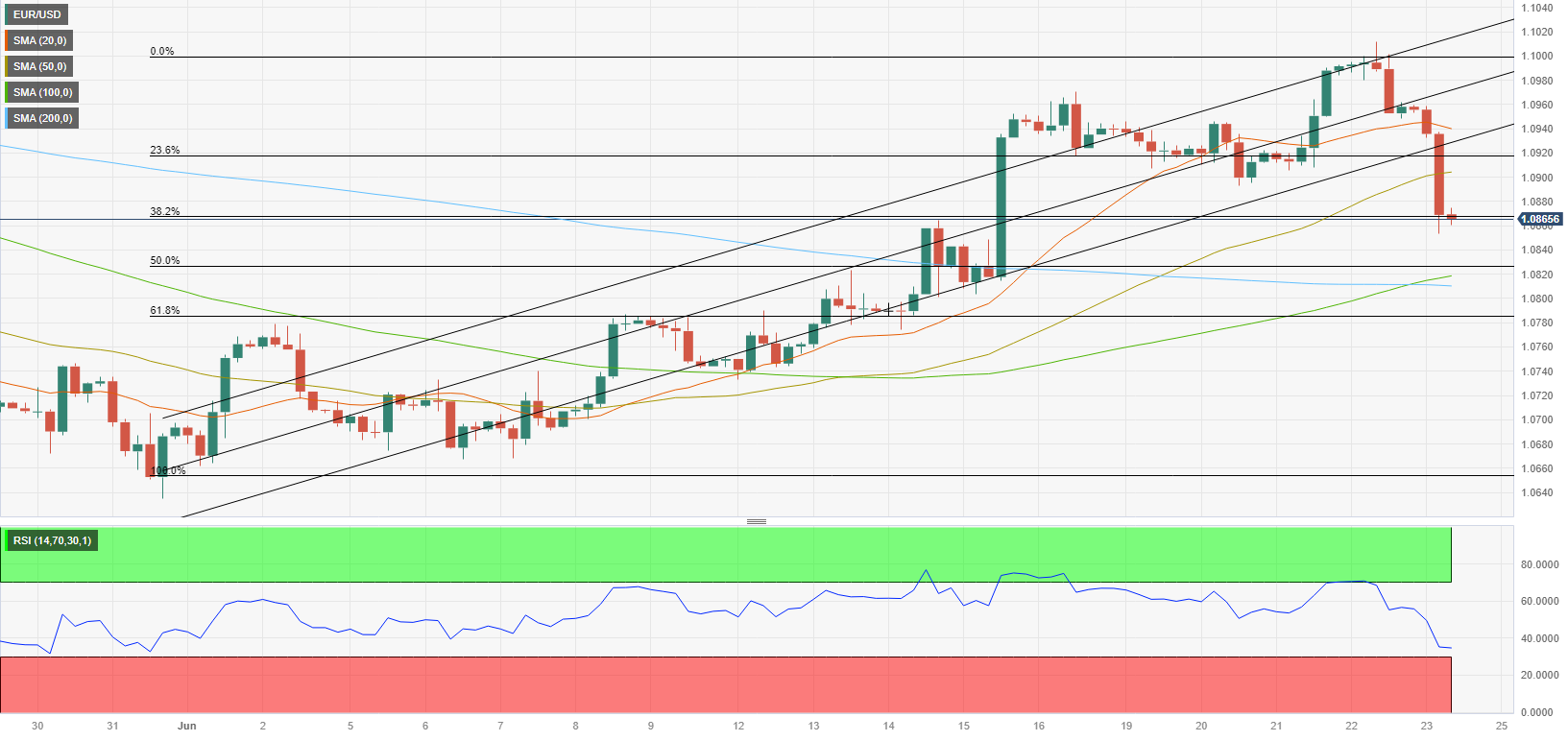- EUR/USD came under strong bearish pressure on Friday.
- PMI surveys signaled a loss of growth momentum in the Eurozone economy.
- Euro could continue to push lower once 1.0870 is confirmed as resistance.
Following Thursday's slide, EUR/USD came under renewed bearish pressure early Friday and broke below 1.0900. In case buyers fail to defend 1.0870, the pair could suffer additional losses ahead of the weekend.
FOMC Chairman Jerome Powell's hawkish rhetoric on the second day of his congressional testimony and the risk-averse market atmosphere helped the US Dollar (USD) outperform its rivals on Thursday. Following a quiet Asian session, the pair turned south once again on growing fears of a recession in the Euro area, touching its lowest level in a week near 1.0850.
Data from Germany and the Eurozone showed that activity in the manufacturing sector contracted at an accelerating pace in early June, with HCOB Manufacturing PMI dropping to 41.0 and 43.6, respectively. Although HCOB Services PMIs held in the expansion territory above 50, they retreated sharply from May levels.
"After Eurozone GDP fell for the second time in a row in the first quarter, the probability has increased somewhat that the GDP change will again carry a negative sign in the current quarter, due in part to weak services activity in France," said Dr. Cyrus de la Rubia, Chief Economist at Hamburg Commercial Bank.
According to Reuters calculations, the 15% probability of a 4.25% European Central Bank (ECB) terminal rate declined to virtually 0% after the release of the PMI readings.
Ahead of the weekend, S&P Global will release Manufacturing and Services PMI data for the US. In case there is an unexpected rebound in the Services PMI, the USD is likely to preserve its strength. On the flip side, a significant decline should have the opposite effect on the USD's valuation.
Market participants will also pay close attention to risk perception. US stock index futures are down between 0.3% and 0.5%. Even if disappointing PMIs weigh on the USD, a bearish reaction in Wall Street's main indexes could make it difficult for EUR/USD to stage a rebound.
EUR/USD Technical Analysis
EUR/USD broke below the lower limit of the ascending regression channel and the Relative Strength Index (RSI) indicator on the 4-hour chart fell below 40, reflecting a buildup of bearish momentum.
EUR/USD was trades near 1.0870, where the Fibonacci 38.2% retracement of the latest uptrend is located. If the pair starts using that level as resistance, it could stretch lower to 1.0820/30 (100-period Simple Moving Average (SMA), 200-period SMA, Fibonacci 50% retracement) and 1.0780 (Fibonacci 61.8% retracement).
On the upside, 1.0900 (psychological level) aligns as interim resistance ahead of 1.0920 (Fibonacci 23.6% retracement) and 1.0940 (lower-limit of the ascending channel, 20-period SMA).
Information on these pages contains forward-looking statements that involve risks and uncertainties. Markets and instruments profiled on this page are for informational purposes only and should not in any way come across as a recommendation to buy or sell in these assets. You should do your own thorough research before making any investment decisions. FXStreet does not in any way guarantee that this information is free from mistakes, errors, or material misstatements. It also does not guarantee that this information is of a timely nature. Investing in Open Markets involves a great deal of risk, including the loss of all or a portion of your investment, as well as emotional distress. All risks, losses and costs associated with investing, including total loss of principal, are your responsibility. The views and opinions expressed in this article are those of the authors and do not necessarily reflect the official policy or position of FXStreet nor its advertisers. The author will not be held responsible for information that is found at the end of links posted on this page.
If not otherwise explicitly mentioned in the body of the article, at the time of writing, the author has no position in any stock mentioned in this article and no business relationship with any company mentioned. The author has not received compensation for writing this article, other than from FXStreet.
FXStreet and the author do not provide personalized recommendations. The author makes no representations as to the accuracy, completeness, or suitability of this information. FXStreet and the author will not be liable for any errors, omissions or any losses, injuries or damages arising from this information and its display or use. Errors and omissions excepted.
The author and FXStreet are not registered investment advisors and nothing in this article is intended to be investment advice.
Recommended Content
Editors’ Picks

EUR/USD regains traction above 1.1000 ahead of US CPI release
EUR/USD has found fresh buyers and jumps above 1.1000 in the European session on Thursday. The pair gains on the German coalition deal and Trump's 90-day pause on reciprocal tariffs, which have lifted risk senitment while exacerbating the US Dollar pain ahead of the US CPI data release.

GBP/USD trades firm above 1.2850, US CPI data awaited
GBP/USD sustains the rebound above 1.2850 in European trading hours on Thursday. The British Pound capitalizes on risk appetite, courtesy of Trump's tariff pause, allowing the pair to recover ground. But further upside hinges on the US CPI data and US-Sino trade updates.

Gold price enters hotspot region with new all-time high possible
Gold price is delivering a jaw-breaking performance this Thursday in the early trading session, moving around $3,107 at the time of writing. Since Tuesday morning, the precious metal has rallied nearly 5.00%. The main driver for the rally came from the United States President Donald Trump who announced a 90-day pause to higher tariffs on 56 countries and the European Union, which will now be taxed at the 10% baseline rate.

US CPI data set to reveal March inflation dip as markets weigh impact of Trump’s tariffs
As measured by the CPI, inflation in the US is set to rise at an annual pace of 2.6% in March, down slightly from the 2.8% reported in February. Core CPI inflation, which excludes the volatile food and energy categories, is expected to ease to 3% in the same period from a year earlier

Trump’s tariff pause sparks rally – What comes next?
Markets staged a dramatic reversal Wednesday, led by a 12% surge in the Nasdaq and strong gains across major indices, following President Trump’s unexpected decision to pause tariff escalation for non-retaliating trade partners.

The Best brokers to trade EUR/USD
SPONSORED Discover the top brokers for trading EUR/USD in 2025. Our list features brokers with competitive spreads, fast execution, and powerful platforms. Whether you're a beginner or an expert, find the right partner to navigate the dynamic Forex market.
